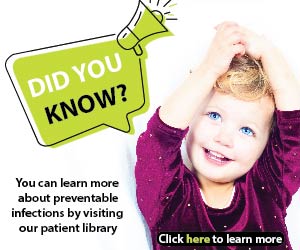Glossary
Our Vaccines411 glossary provides quick and easy access to certain scientific and technical terms featured throughout the website.
Can seem to find a term you’re looking for? Feel free to request it by emailing ac.114seniccav@troppus.
A
Results when exposure to a disease organism triggers the immune system to produce antibodies to that disease. Active immunity can be acquired through natural immunity or vaccine-induced immunity.
- Natural immunity is acquired from exposure to the disease organism through infection with the actual disease.
- Vaccine-induced immunity is acquired through the introduction of a killed or weakened form of the disease organism through vaccination.
Either way, if an immune person comes into contact with that disease in the future, their immune system will recognize it and immediately produce the antibodies needed to fight it. Active immunity is long-lasting, and sometimes life-long. (https://www.cdc.gov/vaccines/basics/immunity-types.html#cdc_generic_section_1-active-immunity)
Allergies happen when the immune system reacts to a foreign substance that gets inside the body. These substances are known as allergens. They include pollen, bee venom and pet dander. Allergies also can happen due to certain foods and medicines that don't cause reactions in most people.
The immune system makes protective proteins called antibodies that attack invaders such as germs. But with allergies, the immune system makes antibodies that mark a specific allergen as harmful, even though it isn't. Coming into contact with the allergen causes an immune system reaction that can inflame the skin, sinuses, airways or digestive system.
Allergic reactions vary from person to person. They can range from minor irritation to a life-threatening emergency called anaphylaxis. While most allergies can't be cured, treatments can help relieve your allergy symptoms. (https://www.mayoclinic.org/diseases-conditions/allergies/symptoms-causes/syc-20351497)
b. of or relating to a substance used to prevent or treat a viral infection
(https://www.dictionary.com/browse/antiviral)
B
- Bacille Calmette-Guérin (BCG) is a vaccine for tuberculosis (TB) disease.
- This vaccine is not generally used in the United States.
- The TB vaccine can cause a false positive TB skin test reaction.
- Tell your health care provider if you have received the TB vaccine.
C
Combination vaccines are made so that two or more vaccines that could be given individually can be administered as one injection. They reduce the number of shots needed while protecting against the same number of diseases.
Combination vaccines are safe. Before a new combination vaccine is approved, it must be shown to be as effective as each vaccine given separately. Side effects of combination vaccines are similar to those of the individual vaccines given separately.
Many of the vaccines available in combinations are not available separately. Therefore, if you turn down one component of the vaccine, all other components are also turned down. For example, refusing the measles vaccine means that a child cannot be immunized against rubella and mumps, either, because the measles vaccine in Canada is only available in combination with the mumps and rubella vaccines.
Examples of combination vaccines:
- Diphtheria, tetanus, pertussis, hepatitis B, polio, Haemophilus influenzae type b (DTaP-HB-IPV-Hib) vaccine.
- Measles, mumps, rubella vaccine (MMR) vaccine.
(https://immunizebc.ca/vaccine-safety/multiple-combination-vaccines)
D
Diphtheria is a contagious disease that is caused by bacteria. Anyone who has not been immunized can get diphtheria.
The symptoms of diphtheria include:
- sore throat
- fever
- difficulty breathing
Diphtheria can be very serious, especially for infants and very young children. It was once one of the most common causes of death in Canadian children under the age of 5.
Fortunately, diphtheria can be prevented through immunization. The diphtheria vaccine is a safe and effective way to protect you and your children. Thanks to immunization, in the last twenty years less than 5 cases of diphtheria are reported each year in Canada. (https://www.canada.ca/en/public-health/services/immunization/vaccine-preventable-diseases/diphtheria.html)
E
Ebola virus disease (EVD or Ebola) is a rare but severe illness in humans. It is often fatal. People get infected with Ebola by touching:
- infected animals when preparing, cooking or eating them
- body fluids of an infected person such as saliva, urine, faeces or semen
- things that have the body fluids of an infected person like clothes or sheets.
Ebola enters the body through cuts in the skin or when touching one’s eyes, nose or mouth. Early symptoms include fever, fatigue and headache.
Some types of Ebola can be prevented with vaccines and treated with medicines. (https://www.who.int/en/news-room/fact-sheets/detail/ebola-virus-disease)
Encephalitis is a rare, serious condition that causes inflammation in your brain so that it swells. It can occur as a result of an infection or an autoimmune process. Encephalitis can be life-threatening, regardless of the cause, and can cause long-term complications and medical issues. Treatment varies depending on the cause, but most people with encephalitis require hospitalization so they can receive intensive treatment, including life support measures.
Types of encephalitis
Condition types include infectious encephalitis and autoimmune encephalitis. Infective encephalitis includes:
- Viral encephalitis: This is the most common form of encephalitis. You can develop viral encephalitis after having certain infectious diseases or viruses.
- Arbovirus encephalitis: Mosquitos, fleas and ticks can spread infections that can become encephalitis.
- Bacterial or fungal encephalitis: Encephalitis from bacterial or fungal infections is the least common type of the condition.
(https://my.clevelandclinic.org/health/diseases/6058-encephalitis)
G
H
Hepatitis is inflammation of the liver. Inflammation is swelling that happens when tissues of the body are injured or infected. It can damage your liver. This swelling and damage can affect how well your liver functions.
Hepatitis can be an acute (short-term) infection or a chronic (long-term) infection. Some types of hepatitis cause only acute infections. Other types can cause both acute and chronic infections. (https://medlineplus.gov/hepatitis.html)
Haemophilus influenzae (Hi) disease is caused by a bacterial infection. The illness can range from mild to severe. Despite its name, Haemophilus influenzae has nothing to do with the influenza virus (flu).
Typically, Hi bacteria cause a mild infection. But severe infection can occur when the bacteria get into parts of the body where they are not usually found. This includes the bloodstream and brain. This type of infection causes invasive Haemophilus influenzae disease.
There are several types of Hi bacteria. Type b (known as Hib) can cause serious and life-threatening illness. Children under 5 are especially at risk.
The best way to prevent Hib disease is by getting a Hib vaccine. Before the vaccine, meningitis was the most common invasive disease caused by Hib. These cases have been reduced significantly because of immunization. (https://www.canada.ca/en/public-health/services/immunization/vaccine-preventable-diseases/haemophilus-influenzae-disease.html)
I
The process of protecting a person or animal from an infectious disease by putting a substance into the body that makes it produce antibodies (= proteins in the blood that fight disease):
- mass/routine immunization
- Immunization gives people the ability to resist infection temporarily or permanently.
- With the use of immunizations in babies, the mortality rate has dropped significantly.
(https://dictionary.cambridge.org/dictionary/english/immunization)
Immunosuppression, also known as immune suppression or immunocompromised, means the immune system isn't working as well as it normally would. This includes any or all of the defenses that make up the immune system - particularly the white cells in the bloodstream, the spleen and the lymph nodes.
When this system is suppressed, ie not working as it should, it leaves people more vulnerable to infection.
Someone who is immunosuppressed is more likely to need antibiotics or hospital admission for a bacterial infection. Most people who are immunosuppressed can't have live vaccines and they may need to take special precautions when traveling.
Immunosuppressed people are also more vulnerable to certain skin cancers. (https://patient.info/allergies-blood-immune/immune-system-diseases/immune-suppression#what-is-immunosuppression)
J
L
M
- Multisystem inflammatory syndrome (MIS) can affect children (MIS-C) and adults (MIS-A).
- MIS is a rare but serious condition associated with SARS-CoV-2, the virus that causes COVID-19, in which different body parts become inflamed.
(https://www.cdc.gov/mis/about/?CDC_AAref_Val=https://www.cdc.gov/mis/about.html)
N
O
P
Poliomyelitis (polio) is a highly infectious viral disease, which mainly affects young children. The virus is transmitted by person-to-person spread mainly through the faecal-oral route or, less frequently, by a common vehicle (e.g. contaminated water or food) and multiplies in the intestine, from where it can invade the nervous system and can cause paralysis.
Initial symptoms of polio include fever, fatigue, headache, vomiting, stiffness in the neck, and pain in the limbs. In a small proportion of cases, the disease causes paralysis, which is often permanent. There is no cure for polio, it can only be prevented by immunization. (https://www.who.int/health-topics/poliomyelitis#tab=tab_1)
Q
R
Rabies is a viral infection in animals that can spread to humans. It is caused by a virus which attacks the nervous system and eventually affects the brain.
To cause an infection, the rabies virus must enter your body and reach your nerve cells. The virus then travels to your brain through your nerves. It reproduces in your brain and then travels back through your nerves to certain parts of your body and causes a variety of neurologic symptoms. (https://www.canada.ca/en/public-health/services/diseases/rabies/causes.html)
S
Sexually transmitted diseases are infections spread mainly by contact with genitals or bodily fluids. Also called STDs, STIs or venereal disease, sexually transmitted infections are caused by bacteria, viruses or parasites.
Sexual activity includes genital touching or sexual intercourse. Anyone who is sexually active can get an STI. You can lower the risk of an STI, and one of the best ways is to talk about STIs with a new partner before sexual activity.
Some STIs cause no symptoms or only mild symptoms. But even with no symptoms, STIs can spread to others. Testing is the only way to be sure if you have an STI.
Some STIs are easy to treat and cure. Others are more complicated. Treatment is important so you don't spread the disease. Treatment also can help prevent fertility trouble, organ damage or some cancers. (https://www.mayoclinic.org/diseases-conditions/sexually-transmitted-diseases-stds/in-depth/std-symptoms/art-20047081)
- Streptococcus pneumoniae bacteria cause pneumococcal disease.
- Certain ages and medical or other conditions put people at increased risk.
- Vaccination is recommended to prevent pneumococcal disease.
Streptococcus pneumoniae are lancet-shaped, gram-positive, facultative anaerobic bacteria with more than 100 known serotypes. Most S. pneumoniae serotypes can cause disease, but only a minority of serotypes produce the majority of pneumococcal infections. (https://www.cdc.gov/pneumococcal/hcp/clinical-overview/?CDC_AAref_Val=https://www.cdc.gov/pneumococcal/clinicians/streptococcus-pneumoniae.html)
T
Tularemia is a disease that can affect both animals and humans. Rabbits, hares, and rodents are particularly vulnerable and are known to die in large numbers during outbreaks. Humans can become infected through various means, such as
- Tick and deer fly bites
- Skin contact with infected animals
- Drinking contaminated water
- Inhaling contaminated aerosols or agricultural and landscaping dust
- Laboratory exposure
V
A supply shortage of a vaccine is defined as an interruption of the supply from the manufacturer to the usual extent that is expected to last for more than two weeks or an unexpected, considerably increased demand which the manufacturer cannot meet to the appropriate extent. (https://www.pei.de/EN/medicinal-products/vaccines-human/supply-shortages/supply-shortages-node.html)p>
Vaccination is a simple, safe, and effective way of protecting you against harmful diseases, before you come into contact with them. It uses your body’s natural defenses to build resistance to specific infections and makes your immune system stronger.
Vaccines train your immune system to create antibodies, just as it does when it’s exposed to a disease. However, because vaccines contain only killed or weakened forms of germs like viruses or bacteria, they do not cause the disease or put you at risk of its complications. (https://www.who.int/news-room/questions-and-answers/item/vaccines-and-immunization-what-is-vaccination)
W
Y
Z
Sources
Note: the hyperlinks that direct to other sites are not continuously updated. It is possible that some links become untraceable over time. Thank you.
Last Updated: May 9, 2024



